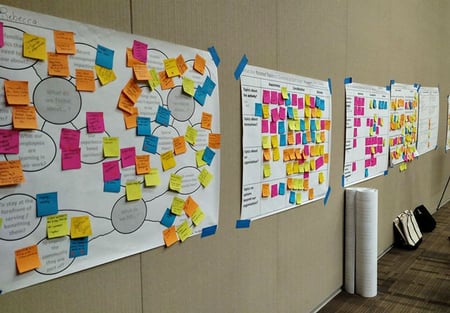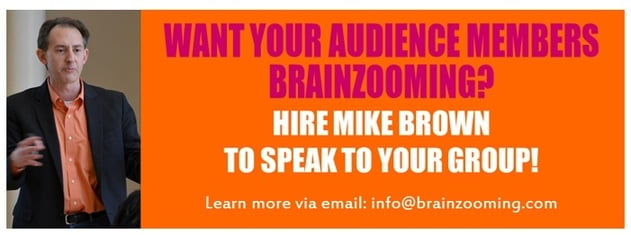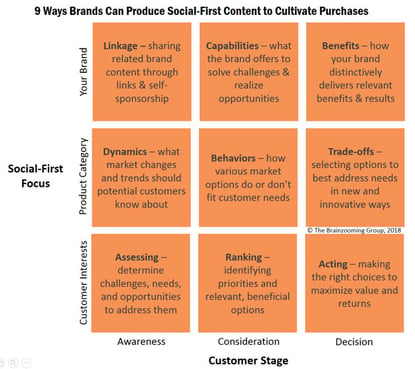I'm at the Social Media Strategies Summit in Dallas today, delivering a two-hour workshop on developing a branded content marketing strategy. The key is finding the right balance between employing outside-in topics and outside-in timing while still making sure your brand personality and messages come through clearly.
We recently conducted a dedicated content marketing strategy workshop for a client on this very topic. We worked with nearly thirty of its business and communication leaders to explore topics four different audience personas would find valuable and that the organization, a healthcare non-profit, could credibly address.
The client is a non-profit focused on healthcare. It entered the workshop with five profiles of target audience members that The Brainzooming Group helped them develop. These profiles, called personas, are three-to-five paragraph descriptions it developed describing specific individuals it serves, seeks to hire, or collaborates with in serving clients. Small groups prepared the personas in advance by brainstorming answers to ten questions on each audience member.
The personas provided the basis for other workshop activities imagining topics audience members would be interested in and willing to read, watch, or listen to if the non-profit were to address them.
Here's an overview of each of the strategic thinking exercises:
5 Content Marketing Strategy Exercises to Generate Audience-Oriented Topics
What questions do audience members ask during the buying journey?
The initial exercise explored three phases of an audience member's journey. The first phase (Awareness) encompassed their initial exploration as they became aware of an opportunity or issue an outside party might address. The second phase (Consideration) involved the audience member describing the relevant opportunity or issue and looking at organizations to help satisfy needs. The final phase (Decision) involved the audience member selecting, engaging, and evaluating the relationship with the outside party they chose.
Within each phase, the small groups identified questions audience members might ask. The comprehensive list of questions each group identified became the basis for the second content marketing exercise.
What topics address important audience questions?
The second exercise used questions from the first one to generate content topic ideas. For each audience question, participants suggested one or more topics or working titles. The topics they generated were not intended to communicate an overtly promotional brand message. Instead, the content would help audience members be smarter in their exploration, evaluation, decision-making, engagement, and post-purchase experiences. As the brand addresses topics of interest to audience members, it has the opportunity to subtly convey its helpfulness, expertise, and audience-focus through sharing beneficial content throughout has the audience journey.
Why do audience members select the brand?
Another exercise focused participants on the relationship stage where audience members either choose or do not choose the brand. Workshop participants identified five primary reasons audience members select the brand. They then identified five reasons audience members do not pick the brand. For each positive reason, they generated multiple topic ideas (of interest to audience members) that would back up the brand's attractive characteristics. For reasons the brand was not selected, they brainstormed possible topics to help counter or refute misperceptions about the brand.
What do audience members say about the brand relationship?
One exercise focused on interactions audience members have with the brand further into the relationship using a 4-box grid. One axis listed "questions" and "statements." The other listed "negative" or "positive" interactions. Each of the four cells named a relevant situation and several questions to trigger potential topics. For instance, positive questions present "Education opportunities," and negative questions signal "pain points.” Positive statements suggest highlighting " brand value.” Negative comments indicate "objections to anticipate." Questions associated with each of these four areas suggested jumping off points for additional topic ideas.
What do we think, know, and do that is relevant for audience members?
Audience members’ interests primarily extend beyond the brand's traditional focus areas. That is why brands focusing only on content about themselves miss so many rich areas in which to share content. To counter this, one exercise explored areas in which audience members exhibit interests, seek information, and focus priorities. For each of the areas identified, participants generated audience-oriented topics. They made the brand connection to the audience based on what the brand thinks about audience interest areas, knows about the information they seek, and does relative to their priorities.
Coming Away with Plenty of Audience-Oriented Topic Ideas
During the Brainzooming content marketing strategy workshop, participants generated hundreds of potential content topics. Before adjourning, each person walked the room to review the topics and select those they thought had particular potential to interest audience members.
The next step is documenting all the topics on a content calendar. This enables the brand to address topics in an organized fashion across the year when, as they can best determine, audience members are most interested in the information.
If you want to learn more about specific details of this approach, contact us. Let’s collaborate to develop richer content that matters to your audiences. - Mike Brown





